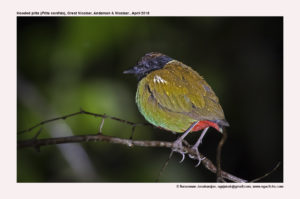
Hooded Pitta Pitta sordida
Etymology :
- Pitta : Telugu Dravidian name pitta – Pretty, Pet
- Sordida : Latin word for Dirty derived from sordes – dirt
Vernacular Names: Lepcha: Phattim pho, Hindi: Topidar Pitta
Distribution in India: Resident of Andaman & Nicobar Island, summer visitor in Himalayas and North East India.
Description: Size of 16–19 cm; 42–80·4 g. The adult of nominate race has entire head, including chin and throat as black, upperparts are dark green, uppertail-coverts and large patch on wing-coverts are turquoise-blue; flight-feathers are black, secondaries are edged green and has a variable white patch on primaries. The tail is black, tipped blue-green; breast and flanks are blue-green or stronger blue. It has a large black central belly patch, lower belly and undertail-coverts are red; iris is dark brown; bill is black; feet are pale brown to pinkish with silver-violet tinge to grey-blue.The Female is sometimes slightly duller and white patch in wing is smaller. Dusky stripes are found on both green and blue upperparts and green underparts. The juvenile is duller than adult, with red-brown forehead, dull greenish above, conspicuous white wing-covert band, white throat, buffy-orange breast becoming buff below, orange tip and base of the bill, and greyish-pink feet.
Habitat: It is found in all types of forest, like primary riverine forest, secondary forest with heavy understorey or scrub, wet or dry forest, also peat swamp-forest, dense bamboo jungle, overgrown rubber or coffee plantations and various other commercial plantations. It is found up to 2000 m.
Food habits: When on land it eats insects of many kinds, beetles, ants, termites, Orthoptera, cockroaches, bugs , various larvae; earthworms and snails. It forages on forest floor among dead leaves, probes among litter, flicks and scrapes aside leaves. It leaps into air to catch termites. It drinks at forest pools during dry periods.
Breeding habits: They breed in Apr–Aug in India; in May–Oct in South East Asia, Malaysia, Thailand, Dec–May in Borneo and Java, Mar–May in Sumatra, Feb–Jun in Sulawesi. The nest is built by both sexes within 3–8 days. The nest is a football-sized flattened dome made of twigs, dead and skeleton of leaves, bamboo leaves, plant fibers, rootlets and moss, lined with finer material, often with a short “walkway” of twigs leading up to side entrance, placed on forest floor. They lay a clutch of 2–5 eggs, laid at 24-hour interval. Both the sexes incubate. The incubation period is 14–16 days. Both the parents feed and tend chicks. The fledgling period is 15–16 days.